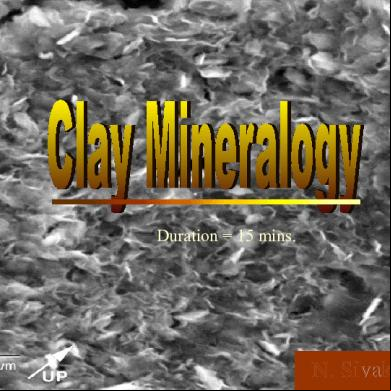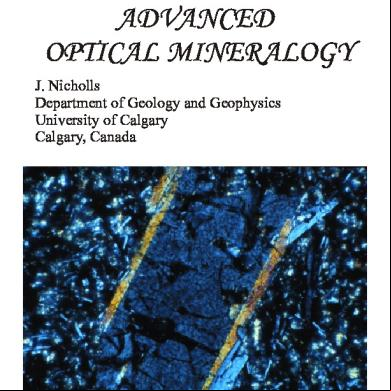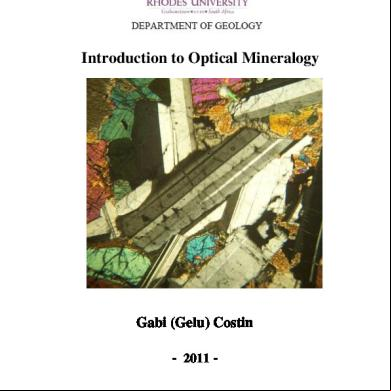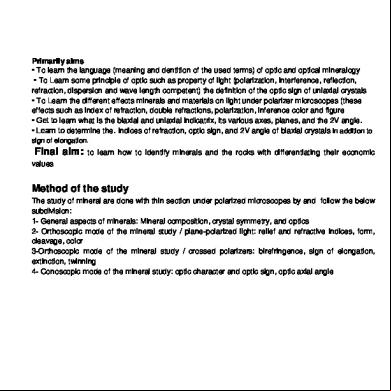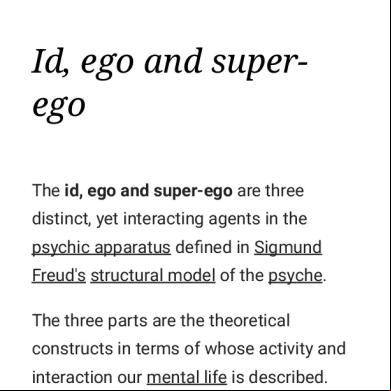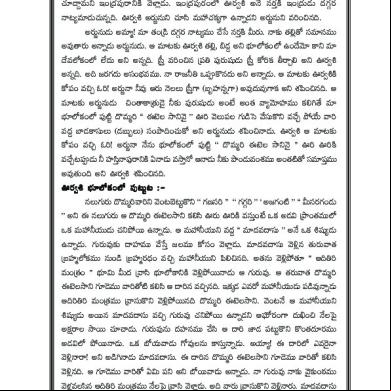Mineralogy 403435
This document was ed by and they confirmed that they have the permission to share it. If you are author or own the copyright of this book, please report to us by using this report form. Report 2z6p3t
Overview 5o1f4z
& View Mineralogy as PDF for free.
More details 6z3438
- Words: 1,062
- Pages: 36
Duration = 15 mins.
N. Sivakugan 1
Copyright©2001
Elements of Earth 8-35 km crust
% by weight in crust O Si Al Fe Ca Na K Mg other
= 49.2 = 25.7 = 7.5 = 4.7 = 3.4 = 2.6 = 2.4 = 1.9 = 2.6
82.4%
12500 km dia SIVA
2
Copyright©2001
Soil Formation Parent Rock
Residual soil ~ in situ weathering (by physical & chemical agents) of parent rock
Transported soil ~ weathered and transported far away by wind, water and ice.
SIVA
3
Copyright©2001
Parent Rock ~ formed by one of these three different processes igneous formed by cooling of molten magma (lava) e.g., granite
sedimentary formed by gradual deposition, and in layers e.g., limestone, shale
metamorphic
formed by alteration of igneous & sedimentary rocks by pressure/temperature e.g., marble
SIVA
Copyright©2001
Residual Soils Formed by in situ weathering of parent rock
SIVA
5
Copyright©2001
Transported Soils Transported by:
SIVA
Special name:
wind
“Aeolian”
sea (salt water)
“Marine”
lake (fresh water)
“Lacustrine”
river
“Alluvial”
ice
“Glacial” 6
Copyright©2001
SIVA
7
Copyright©2001
Basic Structural Units Clay minerals are made of two distinct structural units. hydroxyl or oxygen
oxygen
aluminium or magnesium
silicon
0.26 nm
Silicon tetrahedron SIVA
0.29 nm
Aluminium Octahedron 8
Copyright©2001
Tetrahedral Sheet Several tetrahedrons ed together form a tetrahedral sheet.
tetrahedron hexagonal hole
SIVA
9
Copyright©2001
Tetrahedral & Octahedral Sheets For simplicity, let’s represent silica tetrahedral sheet by: Si
and alumina octahedral sheet by: Al
SIVA
10
Copyright©2001
Different Clay Minerals Different combinations of tetrahedral and octahedral sheets form different clay minerals: 1:1 Clay Mineral (e.g., kaolinite, halloysite):
SIVA
11
Copyright©2001
Different Clay Minerals Different combinations of tetrahedral and octahedral sheets form different clay minerals: 2:1 Clay Mineral (e.g., montmorillonite, illite)
SIVA
12
Copyright©2001
Kaolinite
Typically 70-100 layers ed by strong H-bond no easy separation
Al Si Al Si Al Si Al Si
SIVA
0.72 nm
ed by oxygen sharing
Copyright©2001
Kaolinite used in paints, paper and in pottery and
pharmaceutical industries (OH)8Al4Si4O10
Halloysite kaolinite family; hydrated and tubular structure (OH)8Al4Si4O10.4H2O
SIVA
14
Copyright©2001
Montmorillonite also called smectite; expands on with water Si Al Si
easily separated by water
ed by weak van der Waal’s bond SIVA
Si Al Si Si Al Si
0.96 nm
15
Copyright©2001
Montmorillonite A highly reactive (expansive) clay swells on with water
(OH)4Al4Si8O20.nH2O
Bentonite
high affinity to water
montmorillonite family used as drilling mud, in slurry trench walls,
stopping leaks SIVA
16
Copyright©2001
Illite
ed by K+ ions fit into the hexagonal holes in Si-sheet
Si Al Si Si Al Si
0.96 nm
Si Al Si SIVA
17
Copyright©2001
Others… Chlorite A 2:1:1 (???) mineral. Si
Al
Al or Mg
Vermiculite montmorillonite family; 2 interlayers of water
Attapulgite chain structure (no sheets); needle-like appearance SIVA
18
Copyright©2001
A Clay Particle
Plate-like or Flaky Shape SIVA
19
Copyright©2001
Clay Fabric edge-to-face
Flocculated SIVA
face-to-face
Dispersed 20
Copyright©2001
Clay Fabric Electrochemical environment (i.e., pH, acidity, temperature, cations present in the water) during the time of sedimentation influence clay fabric significantly. Clay particles tend to align perpendicular to the load applied on them.
SIVA
21
Copyright©2001
SIVA
22
Copyright©2001
Scanning Electron Microscope common technique to see clay particles qualitative
plate-like structure
SIVA
23
Copyright©2001
Others… X-Ray Diffraction (XRD) to identify the molecular structure and minerals present
Differential Thermal Analysis (DTA) to identify the minerals present
SIVA
24
Copyright©2001
Casagrande’s PI-LL Chart 60
U-line
Plasticity Index
50
montmorillonite
illite
A-line
40 30
kaolinite
20
halloysite
10
chlorite
0 0
10
20
30
40
50
60
70
80
90
100
Liquid Limit
SIVA
25
Copyright©2001
SIVA
26
Copyright©2001
Specific Surface surface area per unit mass (m2/g) smaller the grain, higher the specific surface e.g., soil grain with specific gravity of 2.7
10 mm cube spec. surface = 222.2 mm2/g SIVA
1 mm cube spec. surface = 2222.2 mm2/g 27
Copyright©2001
Isomorphous Substitution substitution of Si4+ and Al3+ by other lower valence
(e.g., Mg2+) cations results in charge imbalance (net negative) + + + _ _ _ _+ + _ + _ _ _ __ + _ _ _ _ _ __ _ _ _ _ _ _ SIVA
positively charged edges negatively charged faces
Clay Particle with Net negative Charge
28
Copyright©2001
Cation Exchange Capacity (c.e.c) known as exchangeable cations capacity to attract cations from the water (i.e., measure of the net negative charge of the clay particle) measured in meq/100g (net negative charge per 100 g of clay) milliequivalents The replacement power is greater for higher valence and larger cations. Al3+ > Ca2+ > Mg2+ >> NH4+ > K+ > H+ > Na+ > Li+ SIVA
29
Copyright©2001
A Comparison
SIVA
Mineral
Specific surface (m2/g)
C.E.C (meq/100g)
Kaolinite
10-20
3-10
Illite
80-100
20-30
Montmorillonite
800
80-120
Chlorite
80
20-30
30
Copyright©2001
Cation Concentration in Water cation concentration drops with distance from clay particle clay particle + +
+ + + +
++ + + + + + + + + + + + + + + + + + + + + + + + + + + + ++ ++ + +
SIVA
- + cations + - ++ + + + + + + + + + -+ + + + + - + + + + + + + -+ + + + + + -+ + + double layer
+
+ + +
+
+ free water 31
+
Copyright©2001
Adsorbed Water A thin layer of water tightly held to particle; like a skin 1-4 molecules of water (1 nm) thick more viscous than free water SIVA
-
adsorbed water
32
Copyright©2001
Clay Particle in Water
adsorbed water SIVA
1nm 50 nm - double layer - water
free water
33
Copyright©2001
SIVA
34
Copyright©2001
Summary - Clays Clay particles are like plates or needles. They are
negatively charged. Clays are plastic; Silts, sands and gravels are non-plastic. Clays exhibit high dry strength and slow dilatancy.
SIVA
35
Copyright©2001
Summary - Montmorillonite Montmorillonites have very high specific surface,
cation exchange capacity, and affinity to water. They form reactive clays. Montmorillonites have very high liquid limit (100+),
plasticity index and activity (1-7). Bentonite (a form of Montmorillonite) is frequently used as drilling mud. SIVA
36
N. Sivakugan 1
Copyright©2001
Elements of Earth 8-35 km crust
% by weight in crust O Si Al Fe Ca Na K Mg other
= 49.2 = 25.7 = 7.5 = 4.7 = 3.4 = 2.6 = 2.4 = 1.9 = 2.6
82.4%
12500 km dia SIVA
2
Copyright©2001
Soil Formation Parent Rock
Residual soil ~ in situ weathering (by physical & chemical agents) of parent rock
Transported soil ~ weathered and transported far away by wind, water and ice.
SIVA
3
Copyright©2001
Parent Rock ~ formed by one of these three different processes igneous formed by cooling of molten magma (lava) e.g., granite
sedimentary formed by gradual deposition, and in layers e.g., limestone, shale
metamorphic
formed by alteration of igneous & sedimentary rocks by pressure/temperature e.g., marble
SIVA
Copyright©2001
Residual Soils Formed by in situ weathering of parent rock
SIVA
5
Copyright©2001
Transported Soils Transported by:
SIVA
Special name:
wind
“Aeolian”
sea (salt water)
“Marine”
lake (fresh water)
“Lacustrine”
river
“Alluvial”
ice
“Glacial” 6
Copyright©2001
SIVA
7
Copyright©2001
Basic Structural Units Clay minerals are made of two distinct structural units. hydroxyl or oxygen
oxygen
aluminium or magnesium
silicon
0.26 nm
Silicon tetrahedron SIVA
0.29 nm
Aluminium Octahedron 8
Copyright©2001
Tetrahedral Sheet Several tetrahedrons ed together form a tetrahedral sheet.
tetrahedron hexagonal hole
SIVA
9
Copyright©2001
Tetrahedral & Octahedral Sheets For simplicity, let’s represent silica tetrahedral sheet by: Si
and alumina octahedral sheet by: Al
SIVA
10
Copyright©2001
Different Clay Minerals Different combinations of tetrahedral and octahedral sheets form different clay minerals: 1:1 Clay Mineral (e.g., kaolinite, halloysite):
SIVA
11
Copyright©2001
Different Clay Minerals Different combinations of tetrahedral and octahedral sheets form different clay minerals: 2:1 Clay Mineral (e.g., montmorillonite, illite)
SIVA
12
Copyright©2001
Kaolinite
Typically 70-100 layers ed by strong H-bond no easy separation
Al Si Al Si Al Si Al Si
SIVA
0.72 nm
ed by oxygen sharing
Copyright©2001
Kaolinite used in paints, paper and in pottery and
pharmaceutical industries (OH)8Al4Si4O10
Halloysite kaolinite family; hydrated and tubular structure (OH)8Al4Si4O10.4H2O
SIVA
14
Copyright©2001
Montmorillonite also called smectite; expands on with water Si Al Si
easily separated by water
ed by weak van der Waal’s bond SIVA
Si Al Si Si Al Si
0.96 nm
15
Copyright©2001
Montmorillonite A highly reactive (expansive) clay swells on with water
(OH)4Al4Si8O20.nH2O
Bentonite
high affinity to water
montmorillonite family used as drilling mud, in slurry trench walls,
stopping leaks SIVA
16
Copyright©2001
Illite
ed by K+ ions fit into the hexagonal holes in Si-sheet
Si Al Si Si Al Si
0.96 nm
Si Al Si SIVA
17
Copyright©2001
Others… Chlorite A 2:1:1 (???) mineral. Si
Al
Al or Mg
Vermiculite montmorillonite family; 2 interlayers of water
Attapulgite chain structure (no sheets); needle-like appearance SIVA
18
Copyright©2001
A Clay Particle
Plate-like or Flaky Shape SIVA
19
Copyright©2001
Clay Fabric edge-to-face
Flocculated SIVA
face-to-face
Dispersed 20
Copyright©2001
Clay Fabric Electrochemical environment (i.e., pH, acidity, temperature, cations present in the water) during the time of sedimentation influence clay fabric significantly. Clay particles tend to align perpendicular to the load applied on them.
SIVA
21
Copyright©2001
SIVA
22
Copyright©2001
Scanning Electron Microscope common technique to see clay particles qualitative
plate-like structure
SIVA
23
Copyright©2001
Others… X-Ray Diffraction (XRD) to identify the molecular structure and minerals present
Differential Thermal Analysis (DTA) to identify the minerals present
SIVA
24
Copyright©2001
Casagrande’s PI-LL Chart 60
U-line
Plasticity Index
50
montmorillonite
illite
A-line
40 30
kaolinite
20
halloysite
10
chlorite
0 0
10
20
30
40
50
60
70
80
90
100
Liquid Limit
SIVA
25
Copyright©2001
SIVA
26
Copyright©2001
Specific Surface surface area per unit mass (m2/g) smaller the grain, higher the specific surface e.g., soil grain with specific gravity of 2.7
10 mm cube spec. surface = 222.2 mm2/g SIVA
1 mm cube spec. surface = 2222.2 mm2/g 27
Copyright©2001
Isomorphous Substitution substitution of Si4+ and Al3+ by other lower valence
(e.g., Mg2+) cations results in charge imbalance (net negative) + + + _ _ _ _+ + _ + _ _ _ __ + _ _ _ _ _ __ _ _ _ _ _ _ SIVA
positively charged edges negatively charged faces
Clay Particle with Net negative Charge
28
Copyright©2001
Cation Exchange Capacity (c.e.c) known as exchangeable cations capacity to attract cations from the water (i.e., measure of the net negative charge of the clay particle) measured in meq/100g (net negative charge per 100 g of clay) milliequivalents The replacement power is greater for higher valence and larger cations. Al3+ > Ca2+ > Mg2+ >> NH4+ > K+ > H+ > Na+ > Li+ SIVA
29
Copyright©2001
A Comparison
SIVA
Mineral
Specific surface (m2/g)
C.E.C (meq/100g)
Kaolinite
10-20
3-10
Illite
80-100
20-30
Montmorillonite
800
80-120
Chlorite
80
20-30
30
Copyright©2001
Cation Concentration in Water cation concentration drops with distance from clay particle clay particle + +
+ + + +
++ + + + + + + + + + + + + + + + + + + + + + + + + + + + ++ ++ + +
SIVA
- + cations + - ++ + + + + + + + + + -+ + + + + - + + + + + + + -+ + + + + + -+ + + double layer
+
+ + +
+
+ free water 31
+
Copyright©2001
Adsorbed Water A thin layer of water tightly held to particle; like a skin 1-4 molecules of water (1 nm) thick more viscous than free water SIVA
-
adsorbed water
32
Copyright©2001
Clay Particle in Water
adsorbed water SIVA
1nm 50 nm - double layer - water
free water
33
Copyright©2001
SIVA
34
Copyright©2001
Summary - Clays Clay particles are like plates or needles. They are
negatively charged. Clays are plastic; Silts, sands and gravels are non-plastic. Clays exhibit high dry strength and slow dilatancy.
SIVA
35
Copyright©2001
Summary - Montmorillonite Montmorillonites have very high specific surface,
cation exchange capacity, and affinity to water. They form reactive clays. Montmorillonites have very high liquid limit (100+),
plasticity index and activity (1-7). Bentonite (a form of Montmorillonite) is frequently used as drilling mud. SIVA
36
